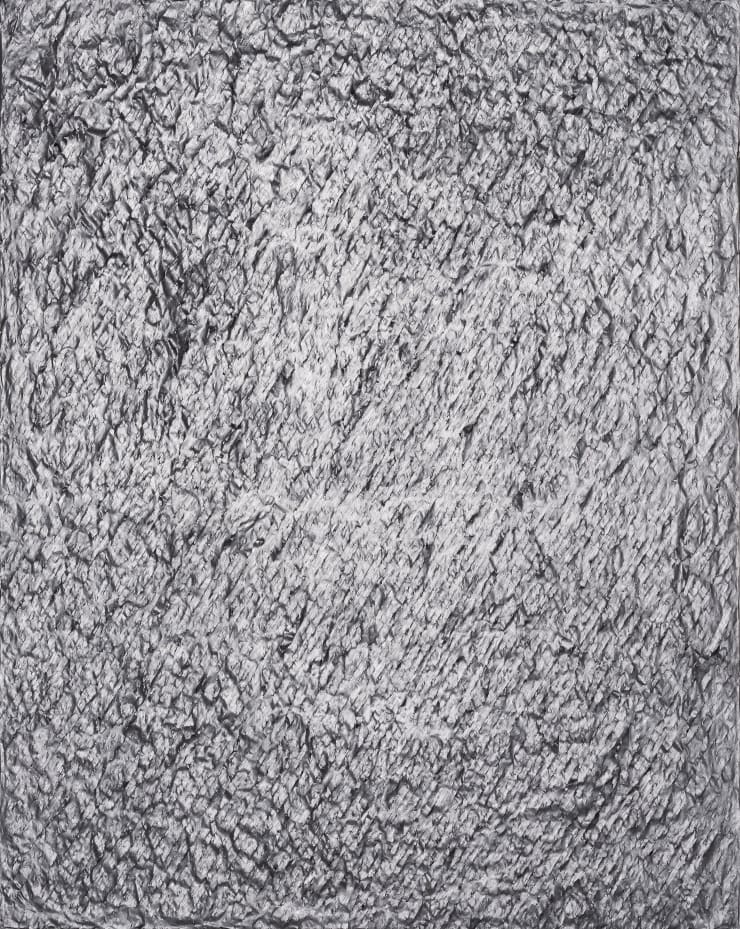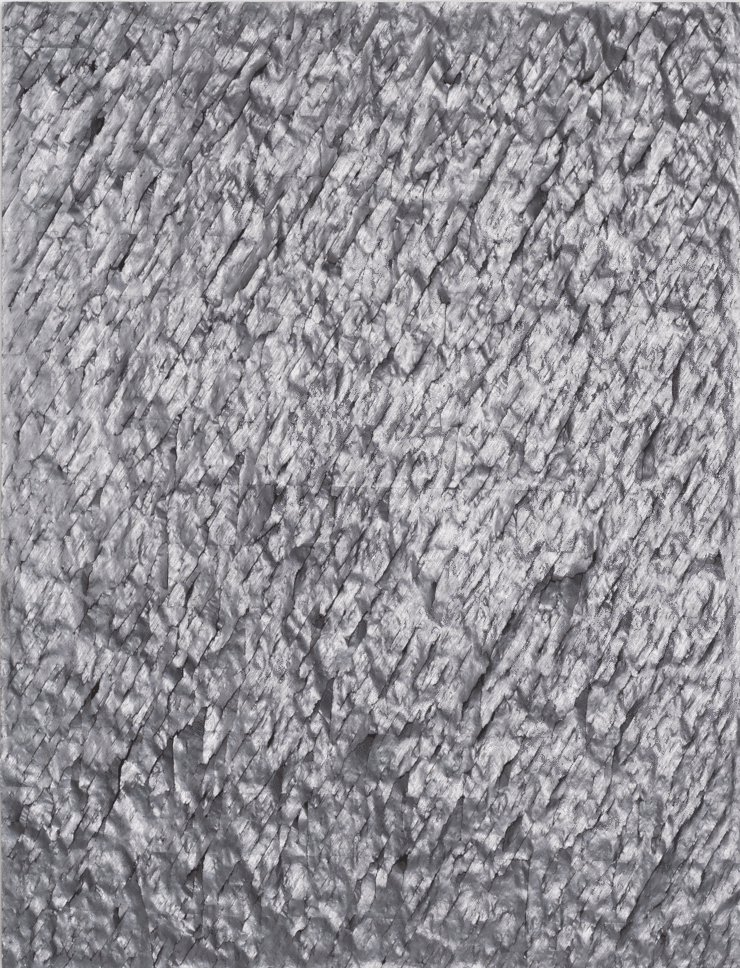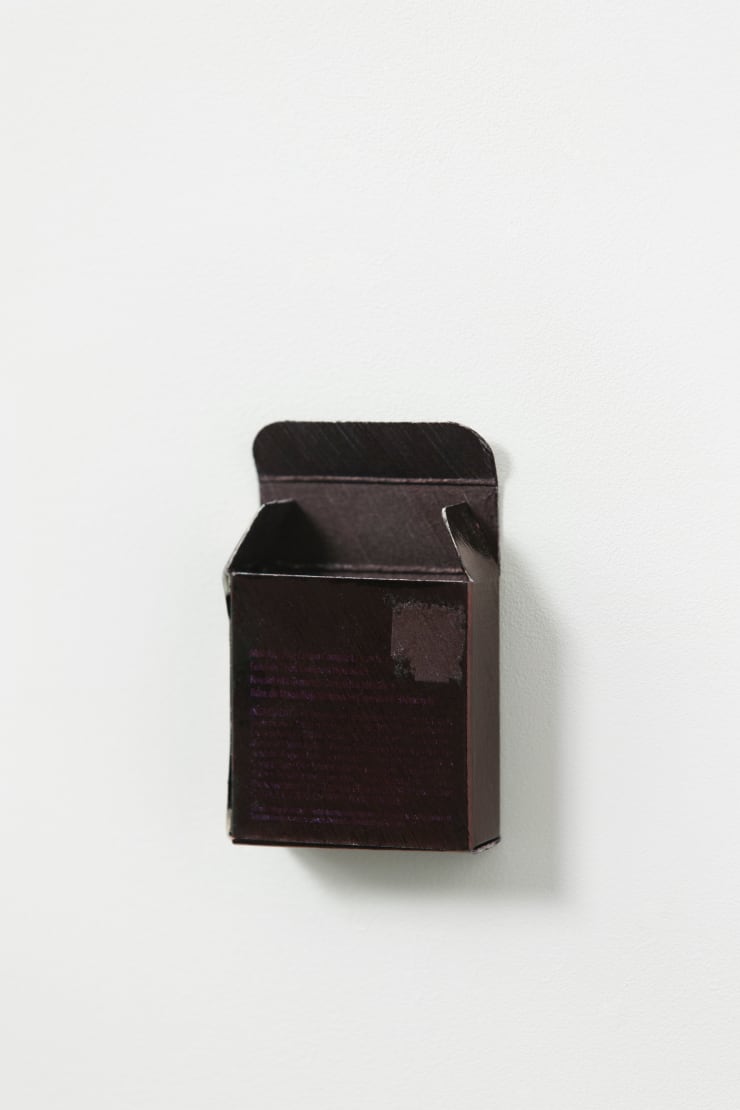CHOI BYUNG-SO
Choi Byung-so holds his solo exhibition at the Wooson Gallery for the second time on July 12, following his first one in 2015. Choi Byung-so’s method is already well known to us: drawing countless lines with pencils and ballpoint pens on newspaper, until pitch-black lines cover the entire surface and the paper is torn here and there by the friction, reaching a physical limit beyond which further work is not possible. As it is, the articles printed on the newspaper are no longer legible, losing its original identity as a newspaper to become something new altogether. Although we realize that its raw material is the newspaper, it is transformed into something that is unique and has a totally different value. What is it that makes this product of mass production, something that was neither valuable nor beautiful, become special and unique?
To find out the reason, we need to look back to the beginning of the 1970s when Choi Byung-so began to produce works using newspapers, and to see the emergence of his work in the context of the times. Choi Byung-so may have had many reasons for choosing the very ordinary material of the newspaper, but in the historical situation of the 70s in which change was happening rapidly both at home and abroad, art rejected existing conservative stereotypes and forms. A wild cry for revolution and new ways to see the world found its expression in the Avant-Garde movement that pursued innovation through new aesthetic approaches and ways of expression all around the world. On the other hand, under the system of the Yushin dictatorship of President Park Jung-hee, in which the industrial development was prioritized, the media was stifled and freedom of expression and communication was suppressed more than ever before. To Choi Byung-so, a young man in his early thirties who lived in such times, newspapers were the most easily accessible form of mass media of the time. Yet he was indignant about the fact that the media was not doing its role properly, and started to cross out newspaper articles with a ballpoint pen. This was the beginning of his work with newspapers.
Nevertheless, Choi Byung-so was able to access foreign literary books that were not published in Korea at the time. This is owing to his mother who was the so-called ‘modern woman’, who received modern education in the 1910s and studied abroad. His ‘free-thinking’ mother had a great influence on the independent thought of Choi, allowing him to break away from conventional ideas and stereotypes. He has been reflecting the social reality of his generation in his work, which could only be expressed by his crossing out the surface of the newspaper pages, the only available area for expression. The proof of his social awareness is found in that what he pursued proves to be an experimental, avant-garde art, rather than L'Art pour l'art. The early beginnings of his work certainly have a historical significance. However, his work that began in the 1970s, lasted for forty years with no sign of slowing down or softening, and therefore should no longer be interpreted as an expression of anger about social irregularities or as a desperate craving for communication. At a first glance over the newspaper surface everything looks the same, but just as the daily newspaper articles reported every day can never be the same as yesterday, our lives exist in a limited time that changes every moment and can never be repeated. The artistic practice of the artist cannot be continued if the human life reaches its physical limits.
However, human labor and time, which are endlessly repeated by the creative will of the artist, accumulate in each work of art as an artistic practice. They give unique values to the trivial everyday product of mass production and cause the temporary to become forever sustainable. Through endlessly repeated labor and time, Choi Byung-so personally demonstrates this artistic practice in his own life.
This exhibition features not only works on newspaper, which is a well-known material for us, but also installations done in early 1975, which introduce replicas of domestic trivia that were mass produced during the industrial development of the 1970s. Besides these, a newspaper work[1] of size 150 catches the eyes of collectors more than anything else. Choi Byung-so was born in Daegu in 1943 and studied Western painting at the College of Fine Arts, Chung-Ang University. Currently, he lives and works in Daegu. He was one of the founding members of the Daegu Contemporary Art Festival, the first contemporary art festival in Korea. He exhibited his works in major group exhibitions held at the National Art Center, Tokyo in 1977, Bienal de Sao Paulo in 1979, and Brooklyn Museum in 1981. He is active internationally with solo exhibitions at Daegu Art Museum in 2012 and the Musée d'art moderne et contemporain Saint-Étienne Métropole in France in 2016.
-
 Choi Byung-SoUntitled - 0180621, 2018ballpoint pen and pencil on paper210 x 164 x 1 cm (150)
Choi Byung-SoUntitled - 0180621, 2018ballpoint pen and pencil on paper210 x 164 x 1 cm (150)
-
 Choi Byung-SoUntitled-0170528, 2017ballpoint and pencil
Choi Byung-SoUntitled-0170528, 2017ballpoint and pencil
on newspaper108 x 80 x 1 cm (50) -
 Choi Byung-SoUntitled-0170131, 2017ballpoint pen and pencil on newspaper47 x 67 x 1 cm
Choi Byung-SoUntitled-0170131, 2017ballpoint pen and pencil on newspaper47 x 67 x 1 cm -
 Choi Byung-SoUntitled 01209, 2012ballpoint pen on paper box2.5 x 6 x 2.5 cm
Choi Byung-SoUntitled 01209, 2012ballpoint pen on paper box2.5 x 6 x 2.5 cm -
 Choi Byung-SoUntitled 01209, 2012ballpoint pen on paper box4.8 x 8 x 1.8 cm
Choi Byung-SoUntitled 01209, 2012ballpoint pen on paper box4.8 x 8 x 1.8 cm -
 Choi Byung-SoUntitled 01209, 2012ballpoint pen on paper box8.2 x 4 x 4 cm
Choi Byung-SoUntitled 01209, 2012ballpoint pen on paper box8.2 x 4 x 4 cm -
 Choi Byung-SoUntitled 01209, 2012ballpoint pen on matchbox8 x 2.7 x 1 cm
Choi Byung-SoUntitled 01209, 2012ballpoint pen on matchbox8 x 2.7 x 1 cm -
 Choi Byung-SoUntitled 01209, 2012ballpoint pen on paper box14.5 x 2.5 x 2.5 cm
Choi Byung-SoUntitled 01209, 2012ballpoint pen on paper box14.5 x 2.5 x 2.5 cm -
 Choi Byung-SoUntitled 01209, 2012ballpoint pen on paper7.8 x 2 x 0.1 cm
Choi Byung-SoUntitled 01209, 2012ballpoint pen on paper7.8 x 2 x 0.1 cm -
 Choi Byung-SoUntitled 01209, 2012ballpoint pen on paper box8 x 3.8 x 1.4 cm
Choi Byung-SoUntitled 01209, 2012ballpoint pen on paper box8 x 3.8 x 1.4 cm -
 Choi Byung-SoUntitled 01209, 2012ballpoint pen on paper box4.5 x 2.5 x 2.5 cm
Choi Byung-SoUntitled 01209, 2012ballpoint pen on paper box4.5 x 2.5 x 2.5 cm -
 Choi Byung-SoUntitled 01209, 2012ballpoint pen on paper box8 x 4 x 1.4 cm
Choi Byung-SoUntitled 01209, 2012ballpoint pen on paper box8 x 4 x 1.4 cm -
 Choi Byung-SoUntitled 01209, 2012ballpoint pen on paper10 x 2.4 x 0.1 cm
Choi Byung-SoUntitled 01209, 2012ballpoint pen on paper10 x 2.4 x 0.1 cm -
 Choi Byung-SoUntitled 01209, 2012ballpoint pen on paper box12 x 4 x 2 cm
Choi Byung-SoUntitled 01209, 2012ballpoint pen on paper box12 x 4 x 2 cm -
 Choi Byung-SoUntitled 01209, 2012ballpoint pen on paper box10 x 4 x 2.8 cm
Choi Byung-SoUntitled 01209, 2012ballpoint pen on paper box10 x 4 x 2.8 cm


















